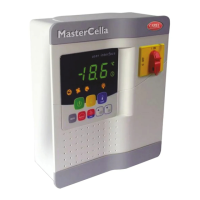41
ENGLISH
ir33 +030220441 - rel. 2.0 - 01.05.2006
dt1: evaporator end defrost temperature set point
This parameter is used to set the end defrost temperature, measured on the evaporator. In any case, the
maximum defrost duration is equal to the value, in minutes, set for parameter dP1.
• if when a defrost is requested, the temperature measured by the defrost probe on the evaporator is
greater than the value set for the end defrost, the cycle is not performed (including the dripping and
post-dripping phases). The same is true for the defrost on start-up, from digital contact, from RTC and
from the keypad;
• if the defrost probe on the evaporator is faulty or disabled, the controller performs a timed defrost, with a
duration equal to the value set for parameter dP1;
• if the end defrost set point is not reached within the time set for parameter dP1, the defrost is stopped. If
enabled (parameter A8), the error Ed1 is displayed, which persists until the start of the next defrost cycle.
In the defrost by temperature, the parameter establishes the threshold for activating or deactivating the
corresponding defrost relay.
Default: dt1=4°C.
dt2: end defrost temperature set point, auxiliary evaporator
dt2 acts in the same way as parameter dt1 described above, but referring to the auxiliary evaporator.
Note for dt1 and dt2: in the defrost by temperature, the parameter establishes the threshold for
activating or deactivating the corresponding defrost relay.
Default: dt2 =4°C.
dP1: Maximum evaporator defrost duration
Determines the maximum defrost duration on the evaporator in minutes (or seconds, see parameter
dC) if defrost by temperature is selected. If timed defrost has been selected, this is the actual duration of
the defrost. Default: dP1=30 minutes.
dP2: Maximum defrost duration, auxiliary evaporator
As for parameter dP1 described above, but refers to the auxiliary evaporator.
Default: dP2=30 minutes.
d3: Defrost start delay
This parameter determines the time that must elapse, when the defrost is activated, between the
stopping of the compressor (electric heater defrost) or the starting of the compressor (hot gas defrost),
and the activation of the defrost relays on the main and auxiliary evaporators.
The delay d3 is useful, in the hot gas defrost, to ensure a suffi cient quantity of hot gas for the defrost
before the activation of the cycle reversing valve, in very special applications (see paragraph “Description
of software functions”). Default: d3=0 minutes.
d4: Defrost when the instrument is switched on
Activates a defrost when the instrument is switched on.
Warning: this request has priority over the activation of the compressor and the continuous cycle.
The possible values are:
d4=0, no defrost is performed when the instrument is switched on;
d4=1, a defrost is performed when the instrument is switched on.
Starting a defrost when the instrument is switched on may be useful in special situations.
Example: frequent power drops occur in the system, which cause the internal clock to be reset. This
clock calculates the interval between two defrosting operations, restarting from zero. If the frequency of
the power failure were, in an extreme case, greater than the defrost frequency (e.g. a power failure every
8 hours, against a defrost every 10 hours) the controller would never perform a defrost. In a situation of
this type, it is preferable to enable defrost on start-up, above all if the defrost is controlled by temperatu-
re (probe on the evaporator), therefore avoiding unnecessary defrosts or at least reducing the running
times. In the case of systems with a large number of units, if selecting defrosts at start-up, after a power
failure all the units will start defrosting, thus causing a voltage overload. To overcome this, the parameter
d5 can be used. It adds a delay before the defrost, and this delay must obviously be different for each
unit.
Default: d4=0 the instrument does not perform a defrost on start-up.
Available on all models except for IR33M.
d5: Defrost delay when the instrument is switched on or from multifunction input
The time that must elapse between start-up of the controller and the start of the defrost.
• if the digital input is used to enable the defrost (see parameter A4=3) or to start a defrost from
external contact (see parameter A4=4), the parameter d5 refers to the delay between enabling of the
defrost or request to enable, and the effective start.
• the defrost digital input (see parameter A4) can be usefully employed to perform defrosts in real time,
connecting a timer to the input. The defrost will be activated when the timer contact closes.
• If several units are connected to the same timer, parameter d5 should be used to delay the various
defrosts, thus avoiding power overloads.
In addition, to avoid unwanted defrosts started by the clock inside the instrument, set parameter dI=0
(manual defrosts only, started from the keypad, by the RTC, by the calculation of the compressor
running time or by the multifunction contact).
Important warning: when connecting a series of units to the same timer, the best solution is to insulate
all the contacts galvanically, fi tting intermediate relays for each contact.
Default: d5=0 => no delayed defrost when switching the instrument on or following the activation of the
multifunction input.

